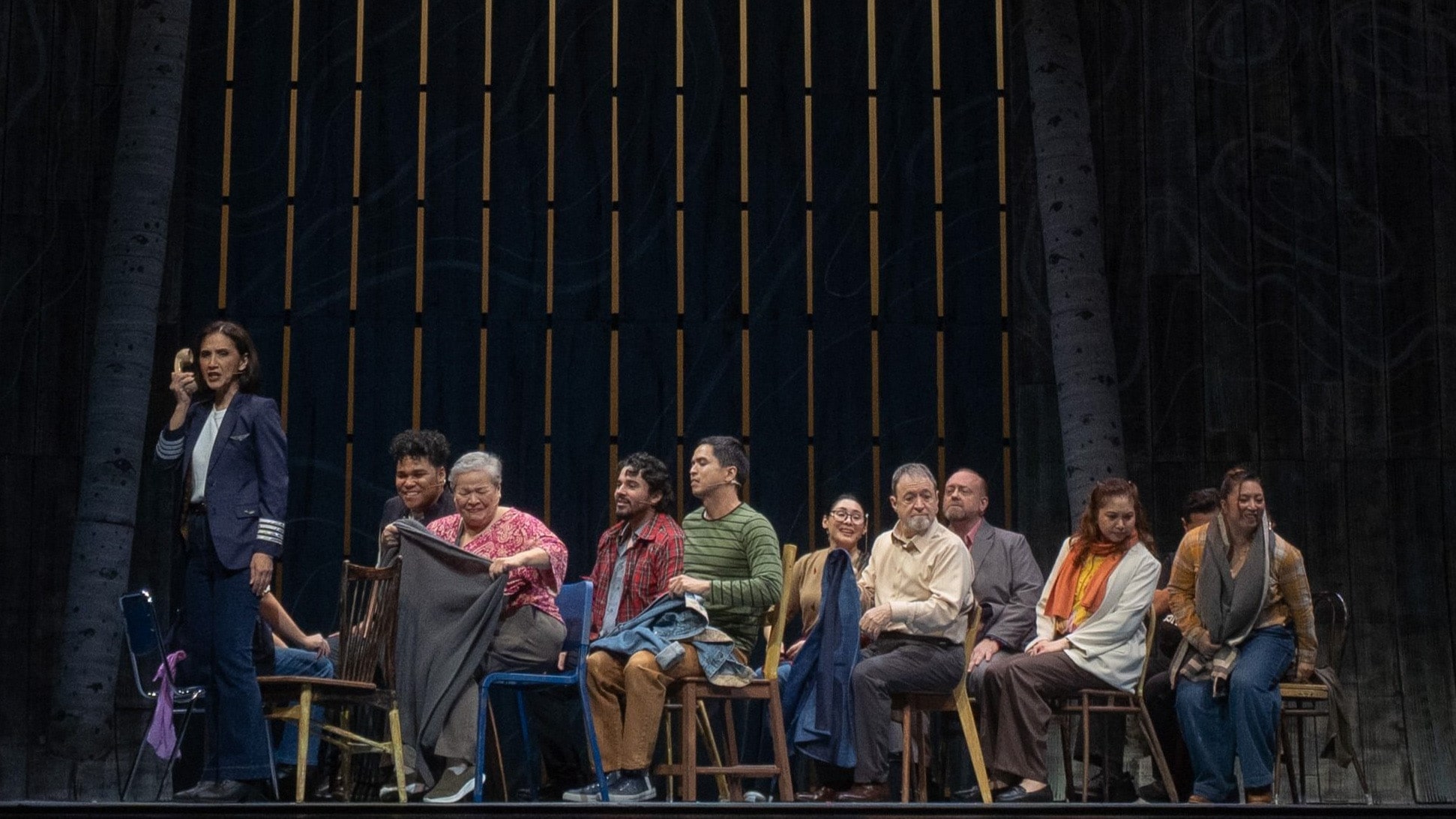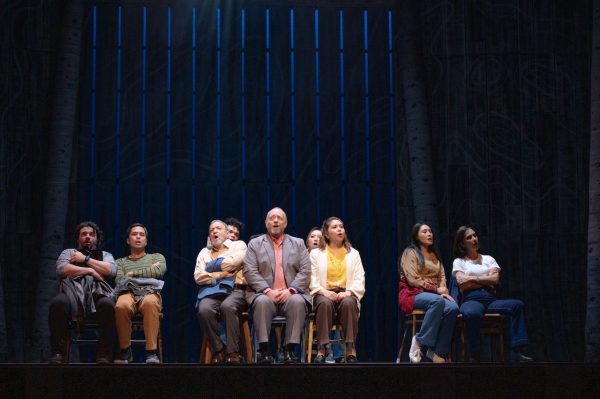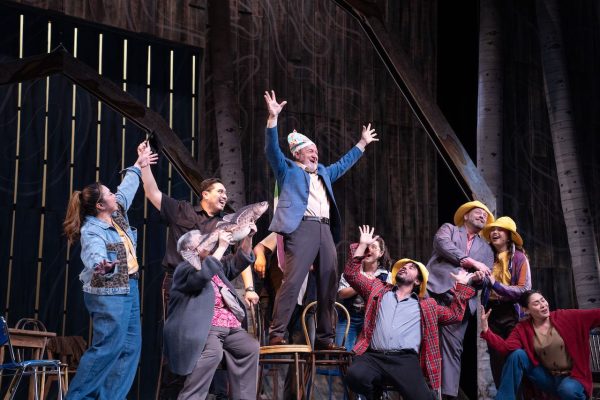
REVIEW: ‘Come from Away’ is a deceptively complex feel-good musical
“Through fluid direction and a folk-inspired score, GMG Productions’ local take on this Canadian musical brings a vibrant sense of community to a difficult subject.”
As easy as it is to call GMG Productions’ Come from Away a “feel-good” musical—about 7,000 stranded airline passengers being taken in by the town of Gander in Newfoundland, Canada on September 11, 2001—what makes the show special is how aware it is about carrying a label like this. With its quaint country accents, everyman characters, and general optimism, it remains surprisingly perceptive about how maintaining positivity during times of crisis can be both life-saving and incredibly difficult to accept.
Moreover, what Come from Away achieves through its fluid direction and folk-inspired score is a vibrant sense of community on stage. Harmony among its cast becomes essential to this story, not only in how its music grows in sound and complexity, but in how the production builds a vivid historical account through people simply sharing space—making it one of the more unique projects one could hope to see coming from Broadway.
Perpetual Motion
While this production doesn’t copy every exact detail from the original 2017 Broadway version (directed by Tony Award winner Christopher Ashley), it’s generally the same show. Mounted on a mostly bare, wooden stage (designed by Kayla Teodoro), it expands its setting by keeping its 12-person ensemble in perpetual motion. Director Michael Williams, movement designer Delphine Buencamino, and lighting designer Harry Tabner constantly guide the actors into various formations that clearly call to mind different locations (inside a pub, on a school bus, in the cramped interior of a plane) just in how the performers and the modest props have been arranged.

The cast of Come From Away; Photo Credit: Zeus Martinez
Even as each actor cycles between multiple roles through simple costume adjustments, the script’s urgent narration of events never loses its momentum during the musical’s 100-minute runtime. The speed at which information is delivered to the audience creates an impressive sense of scale for this emergency, which in turn creates the illusion that the stage is populated by more people than there actually are. Though the sheer number of characters also means that Come from Away’s tone swings from dramatic to comedic, or romantic to solemnly serious, the tonal shifts are part of the point—a community’s varied responses to a situation they’ve abruptly been dropped into.
It Takes a Village
This communal aspect is also reflected in Irene Sankoff and David Hein’s score, which draws from Newfoundland folk music and relies heavily on the entire ensemble, making the musical feel like a song being passed down to future generations. It’s a score that proves challenging to wrangle, as the production’s opening night performance ran into uneven sound, some microphones not being switched on on-time, and slightly missed cues resulting in garbled lines. And the show’s one and only real solo number—the soaring but notoriously difficult “Me and the Sky”—is enough to make the otherwise commanding Menchu Lauchengco-Yulo show noticeable strain and shortness of breath.
But when this cast moves and sings as one unit, all their characters’ varied perspectives and personal backgrounds become connected through tragedy, with kindness, fear, and misunderstanding all stemming from the same places. Songs like the jaunty “Screech In” and the multicultural “Prayer” offer unexpected comfort through humor and spirituality, respectively, while the movement from the triumphant “Somewhere in the Middle of Nowhere” to the gut-wrenching “Something’s Missing” captures survivor’s guilt in all its strange grief.
And while these performers’ accents are generally inconsistent, they compensate with plenty of energy and gentleness towards one another. Sheila Francisco’s teacher Beulah radiates warmth and wisdom towards anyone she shares a scene with; Rycharde Everley’s timid traveler Nick is immediately disarming even with all his vulnerability; and Topper Fabregas, as both the increasingly homesick Kevin J. and the ostracized Muslim passenger Ali, manages to be a source of stinging comic relief and devastating pain.
Cognitive Dissonance

The cast of Come From Away; Photo Credit: Zeus Martinez
That Come from Away can cover such a breadth of emotion with a script that could have easily sounded like a Wikipedia article is a testament to Sankoff and Hein, who also wrote the musical’s book. It’s a fascinating true story on its own, and the two librettists include a dizzying level of detail about the logistics of aircraft maintenance, the protocol of managing and communicating with refugees, and the effects of day-to-day conditions on the needs of thousands of people from all around the world. And it still manages to keep a nimble pace and a lightness of humor to its writing.
But perhaps the smartest thing this show does is not to make an all-encompassing statement about 9/11, when it finds more than enough value in expressing the immense cognitive dissonance brought about by disaster. In the same breath, it celebrates everyday heroism and acts of kindness, but wonders why this often only occurs after so much suffering has taken place first. It offers a glimpse into a society undisturbed by difference, but echoes into the United States’ continuing issues of discrimination and violent foreign policy. It’s a production designed to elicit good feelings, but asks that we pass these feelings on to those around us too.
Tickets: P950 – P5800
Show Dates: June 6–29 2025
Venue: Samsung Performing Arts Theater, Circuit Makati, Makati City
Running Time: approximately 1 hour and 40 minutes (without intermission)
Company: GMG Productions
Creatives: Irene Sankoff (Book, Music, Lyrics), David Hein (Book, Music, Lyrics), Michael Williams (Direction), Delphine Buencamino (Assistant Direction, Movement Design), Rony Fortich (Musical Direction), August Eriksmoen (Orchestrations), Ian Eisendrath (Musical Arrangement), D Cortezano (Technical Direction), Kayla Teodoro (Production Design), Harry Tabner (Lighting Design), Luke Swaffield (Sound Design), Myrene Santos (Hair and Make Up Design), Hershee Tantiado (Costume Design), Joel Goldes (Dialect Coach)
Cast: Caisa Borromeo, Carla Guevara Laforteza, Cathy Azanza-Dy, Menchu Lauchengco-Yulo, Sheila Francisco, Rebecca Coates, Garrett Bolden, Gian Magdangal, George Schulze, Topper Fabregas, Stephen Cadd, Rycharde Everley, Mikkie Bradshaw-Volante, Chino Veguillas, Mayen Bustamante-Cadd


Comments